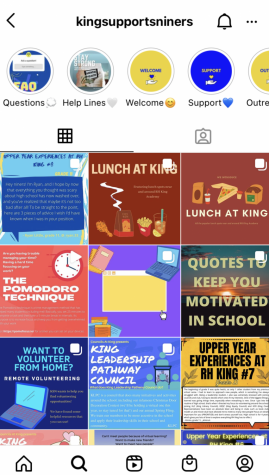KEqC Meeting
The benefits of turning cameras on during remote learning
February 24, 2021
As the TDSB schedule moves into quadmester three, the provincial lockdown and state of emergency have moved most high school classes to remote learning. As a result, staff and students are having to decide whether or not to turn on their cameras during online classes.
The complicated question of whether or not cameras should be used for remote learning began last March. Opinions vary greatly and expectations differ from class to class, but what are the pros of asking students to keep their cameras on?
When it is optional, turning on cameras can have a lot of benefits. Teachers are better able to read the subtle changes in body language and facial expressions which indicate whether students are understanding the material. Oftentimes, they are working to teach skills that need to be seen to be assessed (ex. drama skits or business pitches).
Ms. Hussey is a Performing Arts/English teacher at R. H. King Academy, “I think that having cameras turned ON in class has a tremendous impact on the experience of both students and teachers. Academically, we need connection to communicate together and trust that we are working together. When we lose honest communication, we lose touch with content and growth,” Ms. Hussey says .
During evaluations, having cameras on provides an extra way for teachers to monitor dishonesty. Of course, there is almost no way to eliminate cheating when students are at home, but asking students to turn their cameras on may make them more likely to commit to academic honesty.
For educators, providing remote lessons can be disheartening when they are trying so hard to connect with a screen of empty black boxes. “. . . now more than ever, we need to feel like we are a part of a community. We need to see faces that smile back and visually witness that we are a part of something outside of our own walls. Staring at a screen for hours without any visual cue of our school community only deepens the feeling of isolation,” Ms. Hussey continues.
Some students don’t turn on their cameras or mics, even when spoken to directly, leaving teachers unaware of whether the student is listening, but choosing not to respond, or away from their device entirely. For many teachers, the presence of even a small portion of students with their cameras on is enough to significantly improve their day. It’s a pandemic. We need to take care of each other. We need to show up for each other. So brush your hair – or don’t because it’s not important – and turn your camera ON! — Ms. Hussey
“It’s a pandemic. We need to take care of each other. We need to show up for each other. So brush your hair – or don’t because it’s not important – and turn your camera ON,” Ms. Hussey finishes.
One student perspective for turning on cameras revolves around accountability. When their cameras are on students are pressured to behave accordingly – they may be less likely to wander around their homes, check social media, or fall asleep during class. Many students acknowledge this, but it can be understandably daunting for students to use their cameras – especially when it makes them stand out from the crowd.
The social interaction created by being able to see visual cues benefits students and teachers alike. There are multiple non-video ways to communicate in remote learning, like Jamboards or discussion post features, but in many cases these options don’t truly compare to seeing someone as they speak.
Meeting people and making friends is especially important for this year’s grade nine students who may have never attended in-person high school or have done so in a very limited capacity. At R. H. King Academy, groups like King Supports Niners have been formed to help grade nines adjust to high school online (@kingsupportsniners on Instagram). These groups don’t interact directly with students in class so they are finding alternative ways to help build relationships between students.
“There are several different ways students can make friends outside the classroom. For starters, using social media! It might not be for everyone, but it is such a great tool to message new people who may have the same classes as you, or who might be a mutual friend! Just a simple DM or text can spark a whole new friendship right there,” an executive of King Supports Niners says .
For older grades, many students have made some friends or had conversations with their peers before the pandemic, but this is not the case for most grade nines who may not know anyone in their classes or even their teachers. The new quadmester schedule also means they are meeting new groups of people four times a year instead of the usual two.
King Supports Niners encourages students to access available resources “. . . You can even join our discord server! We have many grade 9s on there who share their day or anything new they learned. During the break, it died down a little. However, we are planning on bringing our discord server back to life and have multiple freshmen students on there and connecting with each other,” the KSN representative states.
Many clubs and councils are working hard to foster engagement from students, but within the day-to-day classes, it can be easy for them to feel isolated from their peers when camera use is low.

Carys McDonald is a grade nine student at R. H. King Academy. “Personally, I think having a camera on in class makes for a much more realistic learning experience which is what I, as a freshman, really need in a time like this. I can’t have much of a normal learning experience right now, but when my classmates’ cameras are on, I feel that I can more easily be an active part of this new learning environment,” Carys says.
The majority of students keep their cameras off, but there are ways teachers can encourage students to participate with video. The easiest is to have cameras on for only a part of the class. In many cases, it doesn’t make sense for students to have their cameras on for the entire time anyway. Video breaks can be taken at the discretion of each person, but also collectively when teachers are screen sharing or students are being asked to review material in another window.
First thing in the morning during attendance, odds are students haven’t been awake long so this is an ideal time to use a non-video feature to check in with students. If they are asked to type something in the chat, for example, they can take a few minutes to eat breakfast or brush their teeth while listening to their teacher, instead of having to awkwardly stare at the screen while unfocused.
Another approach teachers can take to encourage camera usage is to lead by example. If teachers share some of their imperfections and show empathy to student experiences, they create an environment where it is okay for students to do the same. Oftentimes, a toddler wandering into the room or a cat walking in front of the camera is enough to light up people’s faces and give them a burst of happiness that can last through the day.

